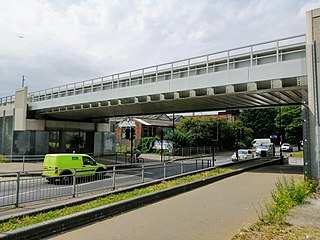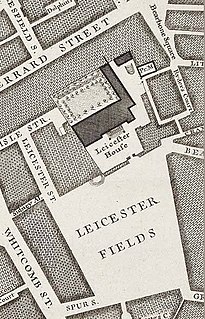Related Research Articles
At common law, damages are a remedy in the form of a monetary award to be paid to a claimant as compensation for loss or injury. To warrant the award, the claimant must show that a breach of duty has caused foreseeable loss. To be recognised at law, the loss must involve damage to property, or mental or physical injury; pure economic loss is rarely recognised for the award of damages.
A homeowner association, or a homeowner community, is a private association-like entity often formed either ipso jure in a building with multiple owner-occupancies, or by a real estate developer for the purpose of marketing, managing, and selling homes and lots in a residential subdivision. In the United States, the developer will typically transfer control of the association to the homeowners after selling a predetermined number of lots.

Planning permission in the United Kingdom is the planning permission required in the United Kingdom in order to be allowed to build on land, or change the use of land or buildings. Within the UK the occupier of any land or building will need title to that land or building, but will also need "planning title" or planning permission. Planning title was granted for all pre-existing uses and buildings by the Town and Country Planning Act 1947, which came into effect on 1 July 1948. Since that date any new "development" has required planning permission. "Development" as defined by law consists of any building, engineering or mining operation, or the making of a material change of use in any land or building. Certain types of operation such as routine maintenance of an existing building are specifically excluded from the definition of development. Specified categories of minor or insignificant development are granted an automatic planning permission by law, and therefore do not require any application for planning permission. These categories are referred to as permitted development.
An equitable servitude is a term used in the law of real property to describe a nonpossessory interest in land that operates much like a covenant running with the land. In England and Wales the term is defunct and in Scotland it has very long been a sub-type of the Scottish legal version of servitudes, which are what English law calls easements. However covenants and equitable servitudes in most of the jurisdictions across North America, are slightly different. The usual distinction is based on the remedy plaintiff seeks and precedent will allow for the scenario in question. Where the terms are unmerged, holders of a covenant seek money damages; holders of equitable servitudes seek injunctions. The term used to exist in England widely before Tulk v Moxhay and as byproduct of the Judicature Acts became one of the fullest mergers of equity and common law in England and Wales so as to agree initially on the term "equitable covenant", then coming to be united in the term covenant save that "equitable" bears a particular meaning in English property rights since at least 1925: it means not fully compliant with registration/written formalities. If lacks legally routine formalities it is not a full legal covenant and therefore more tenuous, often only enforceable personally and against the original covenantor.
A covenant, in its most general sense and historical sense, is a solemn promise to engage in or refrain from a specified action. Under historical English common law, a covenant was distinguished from an ordinary contract by the presence of a seal. Because the presence of a seal indicated an unusual solemnity in the promises made in a covenant, the common law would enforce a covenant even in the absence of consideration. In United States contract law, an implied covenant of good faith is presumed.

The Hindmarsh Island bridge controversy was a 1990s Australian legal and political controversy that involved the clash of local Aboriginal Australian sacred culture and property rights. A proposed bridge to Hindmarsh Island, near Goolwa, South Australia attracted opposition from many local residents, environmental groups and indigenous leaders. In 1994, a group of Ngarrindjeri women elders claimed the site was sacred to them for reasons that could not be revealed. The case attracted much controversy because the issue intersected with broader concerns about Indigenous rights, specifically Aboriginal land rights, in the Australian community at the time, and coincided with the Mabo and Wik High Court cases regarding Native title in Australia.

In real estate, a lot or plot is a tract or parcel of land owned or meant to be owned by some owner(s). A plot is essentially considered a parcel of real property in some countries or immovable property in other countries. Possible owner(s) of a plot can be one or more person(s) or another legal entity, such as a company/corporation, organization, government, or trust. A common form of ownership of a plot is called fee simple in some countries.

Surrey Canal railway station is a proposed station on the South London Line of the London Overground network. It is on its main line.

In contract law, the implied covenant of good faith and fair dealing is a general presumption that the parties to a contract will deal with each other honestly, fairly, and in good faith, so as to not destroy the right of the other party or parties to receive the benefits of the contract. It is implied in a number of contract types in order to reinforce the express covenants or promises of the contract.

English contract law is the body of law that regulates legally binding agreements in England and Wales. With its roots in the lex mercatoria and the activism of the judiciary during the industrial revolution, it shares a heritage with countries across the Commonwealth, from membership in the European Union, continuing membership in Unidroit, and to a lesser extent the United States. Any agreement that is enforceable in court is a contract. A contract is a voluntary obligation, contrasting to the duty to not violate others rights in tort or unjust enrichment. English law places a high value on ensuring people have truly consented to the deals that bind them in court, so long as they comply with statutory and human rights.
The tort of deceit is a type of legal injury that occurs when a person intentionally and knowingly deceives another person into an action that damages them. Specifically, deceit requires that the tortfeasor

A contract is a legally enforceable agreement between two or more parties that creates, defines, and governs mutual rights and obligations between them. A contract typically involves the transfer of goods, services, money, or a promise to transfer any of those at a future date. In the event of a breach of contract, the injured party may seek judicial remedies such as damages or rescission. Contract law, the field of the law of obligations concerned with contracts, is based on the principle that agreements must be honoured.

Scout Moor Wind Farm is the second largest onshore wind farm in England. The wind farm, which was built for Peel Wind Power Ltd, produces electricity from 26 Nordex N80 wind turbines. It has a total nameplate capacity of 65 MW of electricity, providing 154,000 MW·h per year; enough to serve the average needs of 40,000 homes. The site occupies 1,347 acres (545 ha) of open moorland between Edenfield, Rawtenstall and Rochdale, and is split between the Metropolitan Borough of Rochdale in northern Greater Manchester and the Borough of Rossendale in south-eastern Lancashire. The turbines are visible from as far away as south Manchester, 15–20 miles (24–32 km) away.

Smith and Snipes Hall Farm Ltd v River Douglas Catchment Board [1949] 2 KB 500 is an English land law and English contract law appeal decision. The case, decided by Denning LJ, confirmed positive covenants can supplant privity of contract in contracts to improve land and secondly a covenant should be implied where the contract shows an intention that the obligation would attach to the land. The case thirdly held in that context, a somewhat uncertain description of lands which was capable of being rendered certain by extrinsic evidence was sufficient to enforce the covenant.

Hunter v Canary Wharf Ltd [1997] UKHL 14 is an English tort law case on the subject of private nuisance. Several hundred claimants alleged that Canary Wharf Ltd, in constructing One Canada Square, had caused nuisance to them by impairing their television signal. The House of Lords held unanimously that such interference could not amount to an actionable nuisance; the nuisance was equivalent to loss of a view, or of a prospect, which had never previously been actionable.

Wisley Airfield is a former wartime airfield located in the Parish of Ockham near Wisley in Surrey, England. Originally a grass airstrip, the runway was converted to tarmac in 1952 and used to test aircraft built at Weybridge by Vickers. Flying ceased in 1973 because the runway was too short for large aircraft and was too close to Heathrow. All the structures on the site were removed, except for the runway, and the land was sold back to its principal former owner in 1980 for agricultural use.

Tulk v Moxhay is a landmark English land law case that decided that in certain cases a restrictive covenant can "run with the land" in equity. It is the reason Leicester Square exists today.

Wrotham Park Estate Co Ltd v Parkside Homes Ltd [1974] 1 WLR 798 is an English land law and English contract law case, concerning the measure and availability of damages for breach of negative covenant in circumstances where the court has confirmed a covenant is legally enforceable and refused as it may find, as unconscionable, to issue an order for specific performance or an injunction.

English land law is the law of real property in England and Wales. Because of its heavy historical and social significance, land is usually seen as the most important part of English property law. Ownership of land has its roots in the feudal system established by William the Conqueror after 1066, and with a gradually diminishing aristocratic presence, now sees a large number of owners playing in an active market for real estate. The modern law's sources derive from the old courts of common law and equity, along with legislation such as the Law of Property Act 1925, the Settled Land Act 1925, the Land Charges Act 1972, the Trusts of Land and Appointment of Trustees Act 1996 and the Land Registration Act 2002. At its core, English land law involves the acquisition, content and priority of rights and obligations among people with interests in land. Having a property right in land, as opposed to a contractual or some other personal right, matters because it creates privileges over other people's claims, particularly if the land is sold on, the possessor goes insolvent, or when claiming various remedies, like specific performance, in court.

Forge Wood is the 14th residential neighbourhood in Crawley, a town and borough in West Sussex. The 1,900 houses and other facilities will be built on open land in the northeast of the borough, adjoining the ancient village of Tinsley Green and to the north of the Pound Hill neighbourhood.
References
- ↑ England and Wales Court of Appeal (Civil Division), County Council of Surrey & Anor v Bredero Homes Ltd. EWCA Civ 21, published 7 April 1993, accessed 29 December 2021
- 1 2 Oxbridge Notes, Surrey County Council v Bredero Homes Ltd, accessed 29 December 2021
- ↑ Swarbrick, D., Surrey County Council v Bredero Homes Ltd: CA 7 Apr 1993, updated 07 June 2022, accessed 2 December 2022